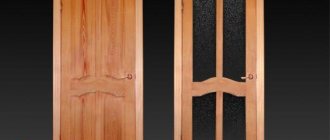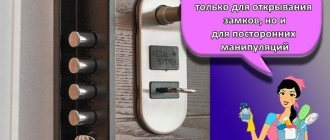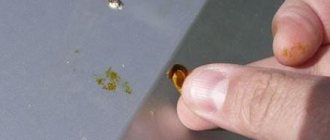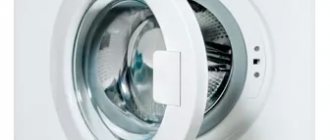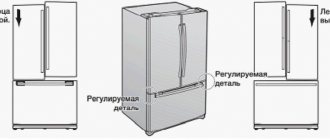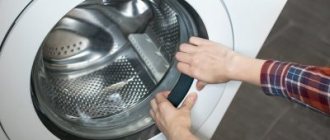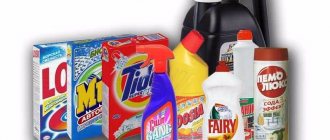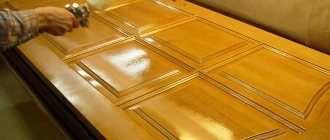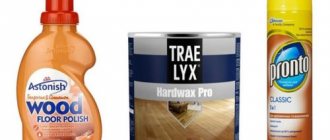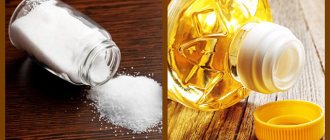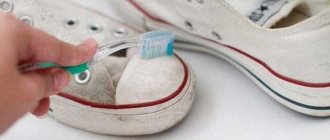This year I whitewashed the barn, our grandmother used to do this, but it didn’t turn out neatly and the iron doors are all stained, I know that I should have scrubbed it right away, but everything is already dry and just can’t be washed off with water. Maybe there are ways to clean an iron door from traces of whitewash?
In general, this is not difficult to do; the main thing here is to make the right decision.
The decision is in the sense of investing in cleaning the door, or trying to get by with little blood.”
If there is a need to save money, then you can try traditional methods of cleaning whitewash from metal doors.
1) 20 grams of vinegar per liter of water, this is not a bad option, there will definitely be no streaks left.
2) Again, per liter of water, 10 grams (milligrams, more precisely) of kerosene. The method is good, but the smell will take a long time to dissipate; if you have to wash a door that “looks” into the room, then an unpleasant smell can put an end to this method.
3) We wash the doors with water, work with a sponge, then until the doors are dry, we go over with a rag soaked in sunflower oil.
When the oil dries, wash it off with water again.
But the best option is to go to the store and buy a special product for cleaning surfaces stained with lime (and not only).
For example, the Probel tool,
The product is good because it has absolutely no odor, the product is concentrated, which means the consumption is minimal.
It is diluted with ordinary water in a ratio of one to one hundred (!). There are no streaks at all, it washes off the first time.
Design Features
Methods for cleaning the door from “installation” and traces of whitewash depend on the material from which the structure is made. Doors can be:
- wooden,
- made of MDF,
- plastic,
- metal,
- glass.
The most commonly used materials for doors are wood or MDF. There are no particular difficulties in cleaning wooden products. But MDF structures can have different types of coating: paint, film, veneer, laminate, etc. Doors with a veneered surface require especially careful care.
Some coatings, for example varnished and painted ones, can deteriorate due to the use of solvents, so you need to be careful when resorting to chemicals.
Methods for cleaning polyurethane foam
Polyurethane foam dries quickly, so the sooner work begins, the greater the chance of cleaning the door without leaving a defect on it. In order to wash fresh polyurethane foam, a special remover or solvent is used.
It is much more difficult to clean dried traces of foam. You can do this as follows:
- Trim the remaining foam as close to the door covering as possible.
- Cover it with solvent, special remover or vinegar. When the foam gets wet, try cleaning the stains using a scraper or a stiff sponge.
- For best results, use a squeegee that is harder than foam but softer than the surface of the door. Clean away traces of foam until you get rid of them completely.
How to remove grease stains
The process of installing new doors is not complete without the use of technical oil to lubricate door hinges. After which greasy spots may appear on the surface. The most effective “weapon” for combating such pollution is starch. Both dry starch and regular raw potatoes will do. Cut the vegetable into 2 parts and rub the cut side onto the greasy stain so that the potato juice is absorbed.
Another alternative way to clean greasy marks on the door is baby powder, which contains talc.
You can also use regular soap solution. But be careful with MDF coatings, which can deteriorate from too much moisture.
Acetic acid is also a good helper in the fight against greasy stains. The greatest effect can be achieved if you apply a mixture of clay and vinegar to the stain. Afterwards, all that remains is to clean the mixture with a slightly damp cloth.
Tip 7: How to restore veneer
Scratches, cracks and abrasions on the surface of the veneer coating can be restored at home. However, only doors finished with natural wood veneer can be restored. To restore minor defects, a special wax pencil is used; its color is matched to the shade of the veneer coating. You need to tear off a small piece from the pencil, knead it in your hands and distribute it evenly over the damaged area. Excess wax mass is wiped off with a soft cloth. Another way to eliminate a defect is to fill the crack or scratch with special liquid wax. The damaged area must first be cleaned of dust and dirt, and then treated with fine-grained sandpaper. Next, you need to apply preheated wax and remove excess with a rag.
To repair serious damage to natural wood veneer, it is best to turn to professionals. They will prepare special “patches” that match the coating in color and texture, and glue them to the area being repaired. If the canvas has deep cracks and chips, the master will first seal them with wood putty.
How to clean paint
The most effective and popular solution for removing paint stains is solvent. However, you should not use it to clean dirt from MDF - it is better to apply alcohol to the surface, and then carefully remove the remaining paint with a blade. Even greater difficulties arise when washing stains from frosted glass.
If it is sandblasting, then you can use a regular solvent. To clean the glossy surface from dirt, use a special scraper. The least problems arise with removing traces of water-based paint, which can be easily washed off with plain water.
How to wash MDF doors
You can remove dirt from fiberboard doors with dishwashing detergent. To do this, take water into a small container and dilute the product in it. Apply foam to the stained area with a sponge and carefully wipe off the stain. We wash off the remaining foam and wipe the door with a clean rag.
- Aqueous ammonia solution. Add 2 tbsp to 500 ml of warm water. spoons of ammonia. This solution is used to remove grease stains. To wash wooden painted canvases, a solution of ammonia is also used, but less concentrated (2 teaspoons of ammonia / 1 liter of water). If severe contamination is present, the concentration of the solution increases (2 teaspoons/200 ml of water).
- Detergents, for example, Domestos, Profit, Shumanit.
- Solvents (white alcohol, acetone) to remove stubborn stains. Aggressive substances must not be used on painted surfaces.
- Baking soda. To clean iron surfaces, use a soda solution, soak a rag in it and wipe the contaminated area. This method is not suitable for washing laminated products.
- Ammonia-based glass cleaner is used to remove fingerprints. This product is suitable for washing plastic and wooden cloths.
- The doors are removed from their hinges, lubricated with the necessary products and adjusted as necessary.
- Additionally, it is recommended to remove the lock and handle and clean it from accumulated dirt and dust.
- The doors should be coated with protective agents, for example, polishes, varnishes, and so on.
- If the fittings are outdated or broken, it is important to replace the glass, handle and other parts.
- If the doors are made according to a certain mechanism design, then it is important to clean the folding parts twice a year.
After repairs, dried stains of whitewash and lime often remain visible on the iron sheet. You can get rid of dirt using sandpaper. It is not recommended to clean vinyl artificial leather metal doors using this method: hard sandpaper will ruin the elastic artificial leather. An effective recipe for removing whitewash stains is to apply vinegar dissolved in water to the stains. In some cases, you can clean a metal door from stains using kerosene diluted with water. After treating the door with kerosene, you should be prepared for the appearance of a strong chemical smell. It will completely disappear in 15-20 hours. Cleaning the door with kerosene is only suitable for metal structures that are used outdoors.
May 21, 2021 uristmed 279
Share this post
- Related Posts
- Amount of Debt Less than the Cost of the Seized Car
- What is the 2021 amnesty in Russia?
- When do you need to do something for a new car?
- Degree of Difficulty of a Variety Number
Methods for cleaning plaster
Dealing with plaster stains on MDF surfaces is quite simple. All you need is a rag, water and a scraper. Avoid getting water on the door to prevent the coating from becoming deformed.
When the putty softens, begin to wash off the dirt with the hard part of the sponge; if it doesn’t come out, use a blade and a scraper. You can also use fine sandpaper for this purpose.
Difficulties arise when washing off putty stains that contain polymers. It adheres well to the surface and in this case it is impossible to do without mechanical action. Polyurethane foam is also used to soften stains.
How to clean frosted or glossy glass
During the renovation process, construction waste may fall on glass elements. How and with what to remove dirt from frosted or glossy glass on a door?
The glossy surface of the glass can be washed with regular glass cleaner. For this purpose, what is always on hand in the house - citric acid, vinegar, alcohol solution - is also suitable.
To clean frosted glass, in addition to the usual glass cleaner, you can use a special care composition that carefully removes stains without damaging the glass structure.
Regardless of the material the door is made from, try not to use strong chemicals or abrasives.
Source
How and how to clean metal and wooden doors after repairs
- Aqueous ammonia solution. Add 2 tbsp to 500 ml of warm water. spoons of ammonia. This solution is used to remove grease stains. To wash wooden painted canvases, a solution of ammonia is also used, but less concentrated (2 teaspoons of ammonia / 1 liter of water). If severe contamination is present, the concentration of the solution increases (2 teaspoons/200 ml of water).
- Detergents, for example, Domestos, Profit, Shumanit.
- Solvents (white alcohol, acetone) to remove stubborn stains. Aggressive substances must not be used on painted surfaces.
- Baking soda. To clean iron surfaces, use a soda solution, soak a rag in it and wipe the contaminated area. This method is not suitable for washing laminated products.
- Ammonia-based glass cleaner is used to remove fingerprints. This product is suitable for washing plastic and wooden cloths.
You may like => The Investigative Committee Refused to Initiate a Criminal Case Against the Investigator Where and How to Appeal This Refusal
To remove whitewash from an iron or wooden surface, use warm water and a soft cloth. Wipe the product with a damp cloth until the stains disappear. It is important to change the water as often as possible. White deposits are removed from glass using a special spray.
Methods for removing whitewash from metal doors
Having decided on the cause of the difficulties encountered when removing whitewash, the question arises of how and how to wash an iron door without streaks.
There are many ways and means to eliminate whitewash stains.
If the whitewash stains are old and dried, it is recommended to rub them with sandpaper, but so as not to damage the surface of the door. Next they move on to wet wiping.
Important! Solutions for combating stains and stains from whitewash on metal doors are diluted in warm water, since the molecules in it are most chaotic, which allows you to knock out chalk particles from the surface.
Folk remedies and recipes for cleaning doors
- Vinegar . The most common anti-whitewash remedy is vinegar. The solution is prepared in the following proportion: pour 20 grams of vinegar per 1 liter of water.
- Kerosene. The method of cleaning steel doors with kerosene solution is effective, but there is a drawback: it is a pungent odor that remains for a long time. If you plan to clean the outside of the door, this is still acceptable, but not the inside. Solution proportions: 10 grams of kerosene are used per 1 liter of water.
- Sunflower oil . The oil method is effective and has no side effects or odors. How to wash whitewash with oil:
- First wash the surface with water using a sponge;
- immediately, until the surface has dried, wipe it with a cloth soaked in vegetable oil.
- After the oil has dried, rinse with water and wipe dry with a cloth.
- Plastic polish with silicone and wax for cars . The method is effective, but helps with minor divorces. It is recommended to wash off the main contamination with water and detergent. After drying, apply polish and rub until the result is achieved. Can be used for steel doors.
- Silicone for lubricating molds . The use of this product uses the same technology as polish, cleaning with water in combination with detergent, and the final silicone accord.
- Probel is not a folk remedy, but is specifically designed to eliminate stains. The diluted product does the job well. Suitable for both metal and wood. After use, the product must be washed off with water.
Photo of Probel
How to clean your front door
How to clean doors from foam
Construction foam that literally sticks tightly to the door surface is a real headache that thousands of people face (and, as a rule, immediately after installing that brand new door). If the same problem affects you, and you don’t have a special remover like Cosmofen at hand, proceed as follows:
1. Scrape off any dried-on material with a plastic spatula. It is permissible to use a knife, blade or rough metal brush, but only if the door leaf has not yet been painted or varnished - noticeable scratches may remain.
2. Protect your hands with gloves and treat the stained areas with pharmaceutical Dimexide (there is no need to rub it in vigorously, just apply generously).
Attention! Before using cleaning fluid on a large scale, test it on an area of the door that is least visible. This rule is relevant for all detergents, since there is always a risk that the coating (especially varnish) will suffer from aggressive components.
3. Let the drug absorb. After about ten minutes, using the same plastic scraper, zero sandpaper or a hard sponge, bring the surface to its proper form.
For the future, it is worth knowing that it is much easier to remove polyurethane foam in a hurry, when it is still fresh: carefully pick it up with a piece of plastic or other non-sharp object at hand, remove the residue with a cloth soaked in solvent (again, after preliminary testing, since acetone can corrode paint and leave whitish streaks).
- When cleaning the door, it is necessary to avoid getting water on the foam in every possible way: the liquid will only fix it, accelerating the hardening process.
- Acetone, which is effective on fresh foam, has no effect on frozen foam - at best, you will waste time, and at worst, you can “seal” the mounting agent even more tightly to the door leaf.
- Don’t even try to use Dimexide on eco-veneer - this material is fibrous and does not easily resist the destructive effects of the drug’s components. Cleaning should be purely mechanical; the use of an abrasive in the form of ordinary soda is acceptable.
- Wooden doors can be easily cleaned with fine sandpaper.
- Mechanical doors that do not have paint coating or spraying can be safely treated with solvents. They cope with the task in literally 10-15 minutes.
- If the iron door is coated with powder paint, do not rush to experiment with “chemistry”, but rather turn to vegetable oil. Any, slightly warmed, is suitable: apply to stains, leave until the foam softens. Next, work with a hard sponge and wash off the oil traces with a soap solution. Attention! This method will not work for wooden and veneered doors, as well as doors finished with MDF.
How to remove whitewash from a door
In comparison with corrosive polyurethane foam, whitewash looks completely harmless, but you still have to work with it. Adding to the concern is chalk, which is not able to dissolve in water - it simply “hangs” in it, making it much more difficult to wash off. Dried whitewash is removed in several steps:
– The main part is removed with sandpaper;
– Next comes the cleaning solution – first you should try vinegar. Ordinary table vinegar is diluted in clean water at the rate of 20 ml per liter, after which, using a sponge or rag, the residual stains are soaked. Alcohol diluted in half can be used with the same success: such a product will not pose a threat even to sensitive varnish.
Tips for removing whitewash from a door
When working with removing stains, you must follow some recommendations.
- If the door is not removed from the awnings, wash it from top to bottom.
- It is better to use natural, moisture-absorbing material for washing.
- You need two rags: one for washing, the second for wiping the door leaf dry.
- If the whitewash is washed off with plain water, it is better to add a little detergent to it to break down fats, which will prevent the chipped chalk from returning to the surface, as it will envelop it and retain it in the water.
- During the washing process, there should be two containers with water, the first for receiving the main dirt, and the second for rinsing the rag before use.
Door after cleaning
To summarize, we can say that you can wash off whitewash from metal doors in different ways, which are effective in their own way. You can purchase a specialized product designed for these purposes.
Source
How to clean whitewash from a door
This year I whitewashed the barn, our grandmother used to do this, but it didn’t turn out neatly and the iron doors are all stained, I know that I should have scrubbed it right away, but everything is already dry and just can’t be washed off with water. Maybe there are ways to clean an iron door from traces of whitewash?
In general, this is not difficult to do; the main thing here is to make the right decision.
The decision is in the sense of investing in cleaning the door, or trying to get by with little blood.”
If there is a need to save money, then you can try traditional methods of cleaning whitewash from metal doors.
1) 20 grams of vinegar per liter of water, this is not a bad option, there will definitely be no streaks left.
2) Again, per liter of water, 10 grams (milligrams, more precisely) of kerosene. The method is good, but the smell will take a long time to dissipate; if you have to wash a door that “looks” into the room, then an unpleasant smell can put an end to this method.
3) We wash the doors with water, work with a sponge, then until the doors are dry, we go over with a rag soaked in sunflower oil.
When the oil dries, wash it off with water again.
But the best option is to go to the store and buy a special product for cleaning surfaces stained with lime (and not only).
For example, the Probel tool,
The product is good because it has absolutely no odor, the product is concentrated, which means the consumption is minimal.
It is diluted with ordinary water in a ratio of one to one hundred (!). There are no streaks at all, it washes off the first time.
And by the way, the product works not only on metal, but also on wood, plastic, and so on, in other words, it will always come in handy around the house.
Don’t forget, after applying the product, rinse thoroughly with water.
The largest component of whitewash is chalk, and chalk has very small particles, so it eats into any surface so that it is very difficult to wash off. Also, when wetting it in water, it does not dissolve in it, but only floats, performing, as they say in physics, Brownian motion.
Therefore, when washing, or rather removing chalk from any surface, you must first use warm water, the main thing is to avoid damaging the other surface with water. In warm water, the molecules are more chaotic and knock out chalk particles from the surface.
You need to add some means to the water to break down fats, but not for the reason of breaking them down, but so that the broken chalk cannot come back, the liquid will envelop it and leave it in the water.
For washing, you will need to use a material that absorbs water very quickly, as well as a rag that can wipe the surface almost dry in a short time.
And while washing, prepare two containers with water, into the first container you will need to drain the already dirty water, wring out a rag or sponge there and partially rinse it in it, and in the second container, dip the rag before using it.
If the door is not removed, wash it from top to bottom:
How to clean a metal door from various contaminants
Steel entrance doors are durable and aesthetically pleasing enclosing structures, the appearance of which matches the design of the room. Metal doors are finished with wear-resistant and durable materials - powder paint, laminate, natural wood, etc. During operation, steel doors become dirty: dust settles on the finishing of the entrance block, hand prints appear. After repair work, particles of cement and putty and other construction mixtures remain on the canvas. Gradually, the enclosing structure loses its aesthetic appearance, and the owner has a question: how to effectively clean a metal door without damaging the surface of the door leaf?
How to remove from different coatings?
There are many proven and effective methods that can return a surface stained with a solution to its original state. These are household chemicals and folk remedies: everyone has the components for them in their home.
From the floor
It is best to wipe off dried putty stains as dry as possible. You should be extremely careful if tiles are laid on the floor: there is a risk of scratching them. If dry cleaning gives an unsatisfactory result, any product with active acids (for example, Toilet Duck) will help wash the surface. We read the composition: we find hydrochloric or any other acid in it.
If not, calmly continue washing:
- We dilute a cap of the composition in two liters of water.
- Apply it to the putty spots and wait a few minutes.
- We are trying to wipe it off. If it doesn’t help, increase your concentration.
- For the most stubborn stains, an undiluted product is suitable.
From the door - wooden and metal
- Dealing with putty stains on a wooden surface is easy. You will need a rag and water:
- When the mass becomes soft, we begin to wash it with the hard part of the sponge.
- If the mixture does not give in, you can use sandpaper. No manipulations with the knife are allowed: this will seriously damage the structure.
- There will be more problems with an iron door. Traditional methods will come in handy: dilute twenty grams of vinegar or kerosene in a liter of cold water. The disadvantage of this method is the specific smell. But after a few hours it will disappear.
In some cases, areas of contamination can be wetted with water and then treated with a sponge and detergent. Any whitish stains that appear can be easily removed with citric acid: pour a little powder into the washing water.
From the tiles
Iron scourers for dishes are useful, as well as a product with acid or alkali - intended for cleaning ovens or plumbing fixtures.
- To lubricate putty stains, dilute it in water.
- Cover the tiles and leave for a while.
When all contaminated areas have been wiped off, wash off the remaining solution and dirt:
- Or mix two tablespoons of soda with half a glass of liquid. We wet the fabric in the resulting mixture and apply it to the affected areas. After about twenty minutes, the building material will be able to rub off the tiles quite freely.
- Solvent liquids will also work. Drop a little acetone or gasoline onto a clean rag and apply it to the stained tile, then rinse with plenty of water.
From the car panel
Car puttying is one of the body repair processes.
Car owners are very concerned about the condition and appearance of their steel horses. The question “how to remove putty from a panel” is a common question on car forums. In the fight against any contamination, the time factor is important: the longer the stain of the solution remains on the car, the more difficult it is to remove it.
- The simplest and most harmless way to eliminate it is with a soap solution. You will need warm water, a sponge and car shampoo. The method will only work on fresh stains.
- If the putty has been left on the car panel for some time, you can try working with nail polish remover without acetone. Wipe the area of contamination with a cloth soaked in the remover, then rinse with clean water.
- Old stains require solvents. They are classified into weak, medium and strong depending on the content of the active substance in them. This composition should be used with caution.
- Clay is popular for car cleaning. In addition, the kit includes wax, polish, and a rag. Rub the clay over the contaminated surface, wait for a while, and then wash off with water.
- Remove the thick layer of putty mortar with a plastic spatula. You must act carefully so as not to damage the outer coating.
From wallpaper
- If the putty is fresh, removing it from the wallpaper is a matter of a couple of seconds:
- We wet a paper towel in water and rub it in a circular motion over the dirty area.
- After final drying, the wallpaper will take on its previous appearance.
- It is possible to remove a dried putty layer from vinyl wallpaper if it has good resistance to moisture.
- To slightly loosen the hardened composition, a scraper is passed over it.
- The putty will begin to crumble, carefully remove it with your hands. At this point, she will easily move away from the wallpaper.
- We carefully pick out the stuck pieces so as not to damage the surface of the canvas.
- Remove remaining oil stains with isopropyl alcohol. Soak a cotton pad in it, apply it and wait. After just 3 minutes, only memories will remain from the stains on the wallpaper.
Putty dust has a negative impact on health: it settles in the respiratory system, causing coughing and pain in the lungs. We must not forget about personal protective equipment.
Glory to the creators
Firstly, getting rid of grease and dirt is much easier than getting rid of foam and paint (you won’t have to use chemicals and harm your health if safety precautions are not followed). Secondly, if you are allergic and have sensitive skin, and just the smell of paint makes your head swim and your vision darkens, call a friend for help, you shouldn’t harm your health.
Cleaning from dirt and grease is carried out taking into account the door coating. For example, if the model is painted with oil paint, then you need to use warm water with alcohol. Pour a liter of water into a bottle and add 5 milliliters of ammonia, then wipe the door. The main rule is not to use detergents with solid particles, as they severely scratch the coating. Because of this, you will have to spend a lot of money on repainting the door.
Steel doors are perfectly cleaned by kerosene, which is used in half the amount of vinegar for the same liter volume. If you are bothered by a persistent pungent odor, you can use the already familiar vegetable oil: apply it to a wet surface (the affected door is rubbed with a sponge soaked in water), leave until it dries. Later, oil traces are washed off with clean water, and the door leaf is wiped dry with a cloth.
The front door is the “face” of the house, and at the same time the calling card of those who live in it. The character and habits of the owners are often judged by its condition, because neat and responsible people will certainly not allow stains, traces of drips and streaks to appear on the surface.
The front door is a design that will last for many years, or even decades. Therefore, the owner of the apartment regularly has to wash it from dirt. And removing them without taking into account the nature of the dirt and the material of the door is problematic. You need to choose a cleaning method so as not to damage the door coating. Therefore, we offer instructions on how and with what to clean a metal entrance door.
To remove common door contaminants typical of the off-season - dust and street dirt - just rub the steel door with a soft cloth dipped in a soap solution. But there are also more persistent stains that require the use of special means. At the same time, it is imperative to follow the rules for cleaning the door depending on the material it is made of - an aggressive cleaning agent can easily damage the outer coating if it does not have anti-vandal properties.
Methods of cleansing
To remove putty residues, you can use several methods. Each of them has its own technological process. The cleaning option depends on the type of coating.
Mechanical wash
The method is simple and does not require any special knowledge or skills.
The main disadvantage is labor intensity. Used: Manual work will take a lot of time. Mechanical processing is permissible for uneven structures:
- The resulting residue is carefully scraped off until completely eliminated. To work, you will need a utility knife or a construction spatula.
- Upon completion, grout with polish or solvent.
Chemicals
The chemical removal method involves wetting the surface with the selected solution.
- The method can only be used for smooth structures: the use of a spatula or scraping knife is inappropriate here. The composition is poured onto the surface, then rubbed with a cloth with large pile.
- The easiest way to remove putty is to soak the contaminated areas with a starch solution, and then remove the residue with a chisel or spatula. The water should be warm, the amount of starch is taken at the rate of two large spoons per liter of liquid.
- Copper sulfate solution is also used:
- Fifty grams of the reagent are diluted in hot water.
- The resulting composition is applied to the desired surface in 3 layers, after waiting for each of them to dry.
How and with what to clean the bucket?
You shouldn’t wait for the solution to set—we start washing buckets, spatulas, and other tools used in the work immediately after it’s finished:
- Pour some water into a bucket and take an ordinary sponge.
- We put on rubber gloves.
- We wash the container like regular dishes: just swipe it with a washcloth a few times and the bucket will shine like new.
If the putty has managed to harden, you shouldn’t throw the bucket away right away - it still has a chance to be saved:
- Pour water and add several packs of citric acid; leave it overnight.
- In the morning, the frozen mass can be easily cleaned.
As an alternative, you can take sulfuric or hydrochloric acid: they are mixed with water in a ratio of 1 to 10. However, such a replacement may not always be safe.
From the video you will learn how to wash dried instruments:
Expert advice
Thoughts about cleaning after renovation appear at a stage when it has not even begun. Simple expert advice will help make the whole process easier:
- During finishing work, we protect doorways with temporary curtains made of polyethylene or thick fabric. The fabric material can be pre-wetted: this will increase its effectiveness.
- We place a wet rag in the gap between the door and the floor: this will block the path of excess construction dust.
- To prevent furniture from being damaged by the repair, it must first be closed and, if possible, completely removed from the room.
- Having completed the “dirty” stage of puttying work, we immediately remove the resulting dust. In this case, it is better not to use a household vacuum cleaner: it will break in no time.
- If it was not possible to get rid of dirt with the help of detergents, we try a recipe with vegetable oil: three tablespoons are needed for five liters of water. Mix thoroughly and wash the floor.
- If clothes get dirty, put them in the freezer. Gradually it will harden and the composition can be easily scraped off. Most should come off in one piece.
- Rubbing alcohol is good at removing traces of putty from both clothing and work surfaces. But it can only be used in well-ventilated areas, away from fire and sparks. The composition ignites instantly.
It is possible to remove the remnants of the putty layer in various ways - with ready-made or improvised means. The choice depends on the material contaminated with the building mixture.
Source
Other contaminants
To remove whitewash from an iron or wooden surface, use warm water and a soft cloth. Wipe the product with a damp cloth until the stains disappear. It is important to change the water as often as possible. White deposits are removed from glass using a special spray.
Solvents will help remove paint from the door. Alcohol will help remove stains from a pressed MDF panel; for this, cotton wool is soaked in liquid, applied to the stain, and left for 15 minutes. Then the paint is wiped off with a rag or carefully scraped off with a blade.
The matte glass surface has a porous structure into which paint is embedded. To clean glass with a sandblasted pattern, solvents are used, and the paint is scraped off from a glossy surface with a special blade. Fresh water emulsion is washed off with water and a clean rag.
Remove fresh primer from the door leaf with a damp sponge. For frozen pieces, use a solution of vinegar, glass and tile cleaning liquid, and ammonia.
Thus, it is not difficult to clean the doors after repair; the main thing is to choose a cleaner depending on the surface material and the type of contamination. To protect the door leaf from various types of stains, cover it with a piece of polyethylene or thick cloth during repair work.

